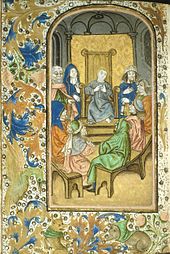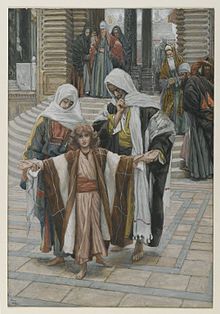- Finding in the Temple
-
The Finding in the Temple, also called "Christ among the Doctors" or the Disputation (the usual names in art), was an episode in the early life of Jesus depicted in the Gospel of Luke. It is the only event of the later childhood of Jesus mentioned in a gospel.
The episode is only described in Luke 2:42-51. Jesus at the age of twelve accompanies Mary and Joseph to Jerusalem on pilgrimage, following "the custom of the feast" (NKJV) - that is, Passover. On the day of their return, Jesus "lingered" in the Temple, but Mary and Joseph thought he had gone ahead of them. Mary and Joseph headed back home and after a day of travel realized Jesus was missing, so they returned to Jerusalem, finding Jesus three days later.[1] He was found in the Temple in discussion with the elders who were amazed at his learning, especially given his young age. When admonished by Mary, Jesus replied "Why did you seek Me? Did you not know that I must be about My Father’s business?"[2] The story was slightly elaborated in later literature, such as the apocryphal 2nd-century Infancy Gospel of Thomas(19:1-12).
The later Jewish custom of Bar Mitzvah for boys at thirteen, considered the age at which a Jewish male would attain responsibility for learning and adhering to the commandments, is recorded some centuries after the description in Luke but may have been the reason for Jesus' visit to the temple and study of the scriptures.
The losing of Jesus is the third of the Seven sorrows of Mary, and the Finding in the Temple is the fifth Joyful Mystery of the Rosary.
 This 15th century page from a Book of Hours shows the typical medieval composition
This 15th century page from a Book of Hours shows the typical medieval composition
Contents
In art
The episode is frequently shown in art, and was a common component in cycles of the Life of the Virgin as well as the Life of Christ. In early Christian depictions, Jesus is usually shown in the centre, seated on a raised dais surrounded by the elders, who are often on stepped benches. The gesture usually made by Jesus, pointing to his upraised thumb (illustration), may be a conventional rhetorical gesture expressing the act of expounding text. These depictions derive from classical compositions of professors of philosophy or rhetoric with their students, and are similar to medieval depictions of contemporary university lectures. This composition can appear until as late as Ingres (Montauban, Musée Ingres [1]) and beyond. From the Early Medieval period the moment shown is usually assimilated to the finding itself, by the inclusion of, initially, Mary, and later Joseph as well, usually at the left of the scene. Typically, Jesus and the doctors, intent on their discussions, have not noticed them yet. From the 12th century Jesus is often seated in a large throne-like chair, sometimes holding a book or scroll.
In late medieval depictions, the Doctors, often now carrying or consulting large volumes, may be given specifically Jewish features or dress, and are sometimes overtly anti-Semitic caricatures, like some of the figures in Albrecht Dürer's version in the Thyssen-Bornemisza Museum in Madrid.
From the High Renaissance onwards, many painters showed a "close-up" of the scene, with Jesus closely surrounded by gesticulating scholars. Rembrandt, who enjoyed depicting Jewish elders in the Temple in various subjects, made three etchings of the subject (Bartsch 64-66) as well as one of the much more unusual scene of "Jesus returning from the Temple with his parents" (B 60). The Pre-Raphaelite painter William Holman Hunt painted a version called The Finding of the Saviour in the Temple, now at Birmingham, as one of a number of subjects from Jesus's life, for which he travelled to the Holy Land to study local details.
The subject has attracted few artists since the 19th century, and one of the last notable depictions may be the one painted, as a forgery of a Vermeer, by Han van Meegeren in front of the Dutch police, in order to demonstrate that the paintings he had sold to Goering were also fake.[3]
See also
References
- ^ The Bible Knowledge Commentary: New Testament edition by John F. Walvoord, Roy B. Zuck 1983 ISBN 0882078127 page 210
- ^ Other translations render Jesus' words "Why were you looking for me? Did you not know that I must be in my Father's house?" and "I must be about my Father's work." See "USCCB - NAB - Luke 2". http://www.usccb.org/nab/bible/luke/luke2.htm#foot13. Retrieved 2010-01-22.
- ^ Image:Van meegeren trial.jpg.
Main source
- G. Schiller, Iconography of Christian Art, Vol. I,1971 (English translation from German), Lund Humphries, London, pp. 124-5 & figs, ISBN 853312702
Boy Jesus at Jerusalem
Life of JesusPreceded by
Settlement in Nazareth,
further preceded by
Massacre of the InnocentsNew Testament
EventsFollowed by
Pilate made Prefect of Judea,
further succeeded by
Baptism of JesusCategories:- Joyful Mysteries
- Gospel episodes
- Christian iconography
- Depictions of Jesus
- Sayings of Jesus
- Gospel of Luke
Wikimedia Foundation. 2010.



